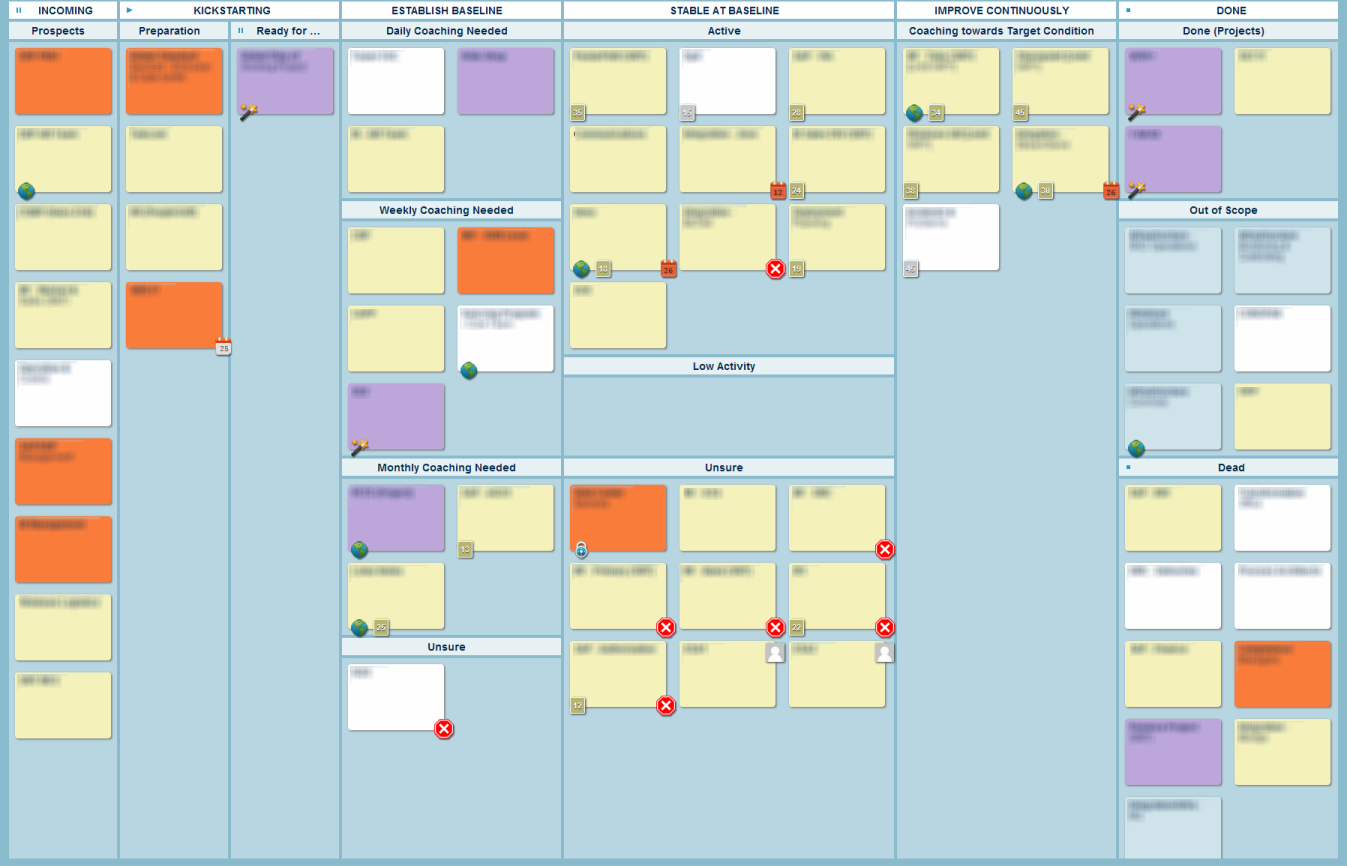Few coaches and many teams. How does that work?
In the Kanban Kick-start Field Guide you mention that you have kick-started more than 50 teams. How do you keep track of the teams and their status?
For our Kanban-coach team, each team really is a work item and, unsurprisingly, we try to see and understand the status of these work item using a board.
Here is our current board (here using Lean Kit):
 |
| A board to visualize the status of the teams we coach (using Lean Kit). |
Ok, so I can see a process here to take care of the teams.
Actually, I would prefer to use another word than “process” as it is quite loaded and make you thing about the wrong stuff. Let’s use “way-of-working”.
Yeah, right, so you visualize your “way-of-working” with the teams.
Absolutely, the various columns on the board reflect the way-of-working described in The Kanban Kick-start Field Guide. A team can be in three states: kick-starting, reaching baseline and improving continuously.
It works like this: a team is in the kick-starting stage from its first contact with us (coaches) until the kick-start workshop is done. Then the team goes into the establish baseline stage where it makes progress until it reaches baseline. A team usually requires daily support right after a kick-start and progressively less and less attention until it is at baseline. Then it goes into improving continuously where the coach helps the manager and team-lead to set challenges and target conditions. Note that a team in improving continuously is always working with a target condition.
Cool! But why do you have a ‘Done’ column? After all the teams are supposed to “improve continuously”, and… OMG I see dead teams!
You are – of course – right: a team should improving continuously. But this is not always the case: when a project ends some of the teams can be discontinued, some teams become “out-of-scope” if they are out-sourced, and teams can die. There can be several reasons why a team “dies”: a re-organization can dissolve the team, demand can dry-out and lack or disappearance of management attention can wither-out the best teams.
But…so many dead!
Like all big companies, we have just been through a re-organization which explain that quite many teams were discontinued or out-sourced. Though, from a coaching perspective it is not big problem as the members of these teams are now spreading their experience and knowledge to other teams that, eventually, will request coaching (these are pilling in the Prospects column).
You previously mentioned three states for a team but I can see a fourth one “stable at baseline”. What’s that?
In practice, we discovered the need for an in-between state after reaching baseline and before improving continuously. The reason is simply that improving continuously is hard! It requires a motivated team and good management attention. Some teams could not have sufficiently of one or the other, or both, to start improving or to stay in the improving state. So, you will find here teams that have been in improve continuously but are not working with any target condition right now, and teams that have never really started improving. These teams are very important to support, but the root cause is often not a lack of coaching but a lack or inability to get the right management attention/motivation.
By the way, the “Unsure” state is simply that the coach-team needs to re-assess the team’s situation (actually I should go and see these teams rather than write this blog entry). The X:s visualize discovered blocks or impediments that must be solved for the team to move forward.
How long does it take for a team to reach the improving continuously state?
Of course, we want all the teams to move from the kick-starting to the improve continuously state a.s.a.p. (short lead-times). For some teams it may take some weeks, up to a month. Unfortunately, for most of the teams that actually takes time: the context makes it hard to improve rapidly, organizational changes rub our plans, key persons come and go, etc. So, a team may well take months to move from “kick-starting” to “improve continuously”. The challenge it not really to reach the improving continuously state, but to stay there!
What are the different work types that you are using?
We have five different types of team: development teams (most common), projects (usually rather short-lived), coordination teams and management teams.
What are these little icons?
They are used to illustrate extra information on the teams. For example a globe visualizes that the team is working purely distributed (with digital boards, video conference equipment, etc.). The “magic wand” is for illustrating that we have also helped the team to create a release plan using the User Story Mapping technique (these are in general project teams).
The numbers attached to some of the teams are the latest result of a “Depth of Kanban” exercise. Generally, teams in the improving continuously state have high “depth” scores (these scores are only used by the coaches and the teams themselves). It can also happen that teams with great scores can slip down from the improve state and loose depth due to organization changes (e.g. reduced team size, changed team members, etc.).
How do you use this board?
Like all Kanban teams, we use this board to see and understand our current condition and plan our work. We get into very interesting dilemma: do we spend our (limited) energy to help a team stay of the improving state, or do we help a team stuck at the stable at baseline to reach improving? You tell me!



